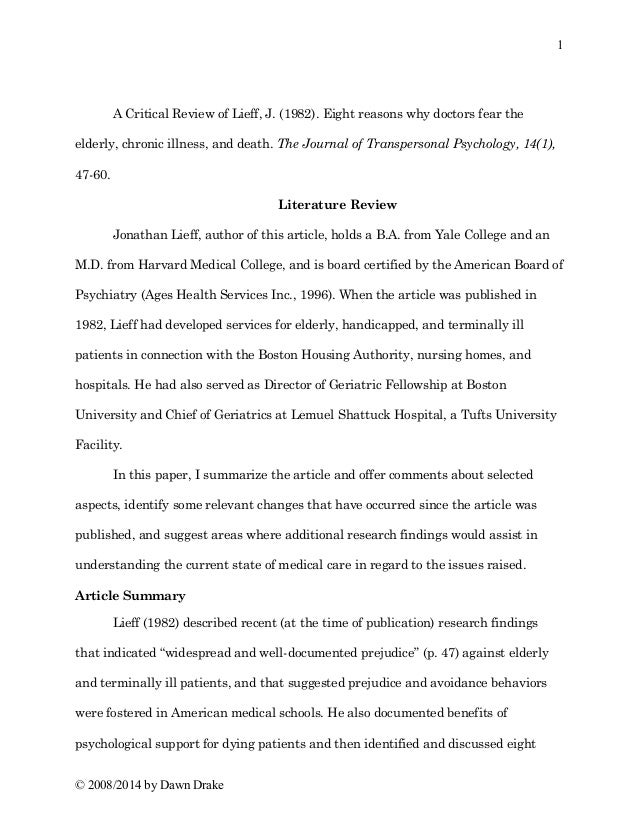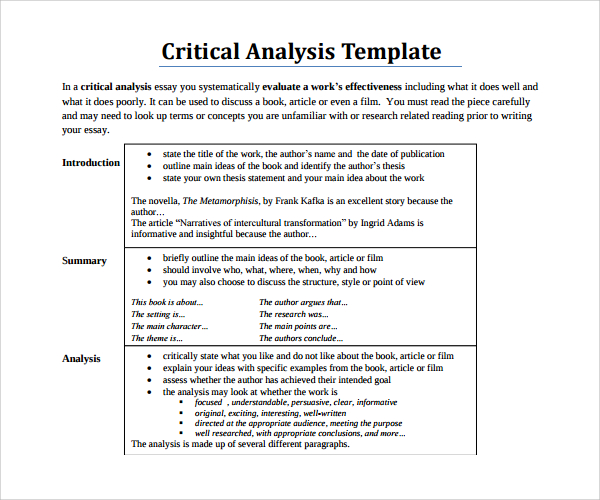
A critical summary is a series of short paragraphs that provide an overview of the strengths and weaknesses of the sources you found. The primary task of your summary is to highlight how well your sources helped you answer your research questions 25/6/ · To write a critical summary of an article, you need organized and objective critical thinking as well. The process of writing a critical summary includes brainstorming to form a list of questions, answering these questions one by one and then finalizing your 13/10/ · Write weekly: Give ample time to read the article before class, discuss in class and then write the critical summary when the ideas are still fresh in your mind. Your class discussions are valuable in helping you with the writing process, so it is wise to take notes during these discussions
How to Write a Critical Summary of an Article | The Classroom
Some research tasksparticularly the source investigationrequire you to write a summary of your research findings. A critical summary is a series of short paragraphs that provide an overview of the strengths and weaknesses of the sources you found.
The primary task of your summary is to highlight how well your sources helped you answer your research questions. Please be aware that you are not simply giving your opinion about whether you liked your sources or not: you need to draw upon what you said in your source analysis and evaluation section in order to justify your conclusions, how to write a critical summary of an article. Required elements:. There are a number of different ways that you can structure your critical summary.
Depending upon what you can say about the usefulness and reliability of your sources and how to write a critical summary of an article you intend to answer your research questions, you can follow any of the following approaches. Approach 1: Compare primary and secondary sources. Paragraph 1: What information did your primary sources provide?
Paragraph 2: What information did your secondary sources provide? Paragraph 3: Based upon your research, how would you answer your Key Inquiry Question? Paragraph 1: Based upon your research, how would you answer your first sub-question? Paragraph 2: Based upon your research, how to write a critical summary of an article would you answer your second sub-question? Paragraph 3: Based upon your research, how would you answer your third sub-question?
Paragraph 4: Based upon your research, how would you answer your Key Inquiry Question? Paragraph 1: Which sources were the most useful sources in answering your sub-questions. Paragraph 2: Which sources were the most reliable? The archaeological and written sources indicate that Roman propaganda stressed the importance of military victories in establishing imperial legitimacy. However, these sources were clearly created by and for members of the social elite and, as a result, only reflect the perspective of these people.
Whilst the purpose of the statues and histories were to influence the loyalties of wealthy aristocrats, we have no way of knowing what effect they had on the rest of the people in the city, as their thoughts are not preserved in the extant sources.
Regardless, Tacitus is crucial to answering my two sub-questions about senatorial and military understandings of imperial rule, especially when he outlines the failings of previous emperors in the eyes of the various social groups in Rome Annalshow to write a critical summary of an article, IV.
As both of these sources are contemporaneous with the imperial system, they are a particularly reliable source of the perspectives of the Romans themselves.
What I found most useful, specifically when researching information on the views of the non-Romans about emperors' attempts at justifying their power were the works of modern historians.
Cambridge University classicist, Mary Beard provided substantial detail about the use of statuary in Egypt and the Levant which provided a counterweight to the ancient sources I found Brewer to be less useful, even though he is a professor of Ancient History, since he focused more on the actions of the emperors themselves, rather than how to write a critical summary of an article broader sections of society As a result, I found the academic works of modern historians most useful in providing a critique of the Roman perspective of the ancient sources.
Based upon the evidence I have gathered from ancient and modern sources, I concluded that the Roman emperors believed that military victories were the primary mode of establishing imperial legitimacy to their subjects, despite the fact that only the upper classes of society were influenced by it.
The sources that I have chosen at the completion of my research have all been incredibly useful in answering my research questions. In particular, evidence from Shirer proved invaluable in answering my sub-question about how the Nazi party came to power, since the author took part in many of the events he describes What proved particularly helpful to me was how much Greiger, emeritus professor of political history at Harford corroborated the finer details provided by Shirer While I found the two Nazi propaganda articles in the Der Stürmer helpful in answer my second two sub-questions, I found the level of antisemitic bias difficult identify in every instance.
Despite this, I could confidently answer my first sub-question by showing that print media was central in manipulating public opinion during the Nazi rise to power. The academic works by Greiger and Stanton proved to be the most reliable. This is firstly due to their credentials as history professors with a combined fifty years of research experience between them. This gave me a lot of confidence to then go back to the political posters and cartoons, particularly those I found on the Holocaust Museum website, and identify specific word choices that helped me answer my final two sub-questions.
History Skills has a ready-to-use Research Journal that follows these 9 steps and provides links back to the website to help you at each stage of your research. You can grab it here. Contact via email. Home For Students For Teachers Studying History Historical Knowledge Background Knowledge Chronology Change and Continuity Causes and Consequences Significance Motives and Historical Empathy Researching 1.
Key Question 2. Background Research 3. Sub-questions 4. Source Research 5. Organise Quotes 6. Topic Sentences 7. Hypothesis 8. Draft Writing 9. Researching Critical Summary. Critical Summary. Image by Couleur.
Used under Creative Commons CCO, how to write a critical summary of an article. What is a 'critical summary'? Required elements: Based upon what your sources said, provide potential answers to your Key Inquiry Question and Sub-Questions Mention specific sources by name and outline their strengths and weaknesses Use correct in-text referencing when providing direct and indirect quotes from sources.
Structuring your critical summary. Approach 1: Compare primary and secondary sources Paragraph 1: What information did your primary sources provide? Approach 2: Answer each sub-question Paragraph 1: Based upon your research, how would you answer your first sub-question?
Approach 3: Group by evaluation skill Paragraph 1: Which sources were the most useful sources in answering your sub-questions Paragraph 2: Which sources were the most reliable? Using Approach 1. Using Approach 3. Need a digital Research Journal? History Research Journal A ready-to-use digital student research journal that follows the same 9-step research process from the History Skills website. Each research stage has explanations, blank tables and hyperlinks to examples to aid with the completion of essay Read More.
Search the website:. Follow History Skills on:. Support History Skills:. About Privacy Policy With the exception of links to external sites, some historical sources and extracts from specific publications, all content on this website is copyrighted by History Skills, how to write a critical summary of an article. This content may not be copied, republished or redistributed without written permission from the website creator. Please use the Contact page to obtain relevant permission.
Log in Log out Edit.
Helping Students Identify Fake News with the Five C's of Critical Consuming
, time: 2:56Writing a Critical Summary | CanLit Guides

A critical summary is a series of short paragraphs that provide an overview of the strengths and weaknesses of the sources you found. The primary task of your summary is to highlight how well your sources helped you answer your research questions 6/9/ · How to Write a Summary of an Article. 1. Identify the Main Idea or Topic. The aim of an article is to convey a certain idea or topic through the use of exposition and logic. In a summary, 2. Identify Important Arguments. 3. Write Your Summary 25/6/ · To write a critical summary of an article, you need organized and objective critical thinking as well. The process of writing a critical summary includes brainstorming to form a list of questions, answering these questions one by one and then finalizing your
No comments:
Post a Comment